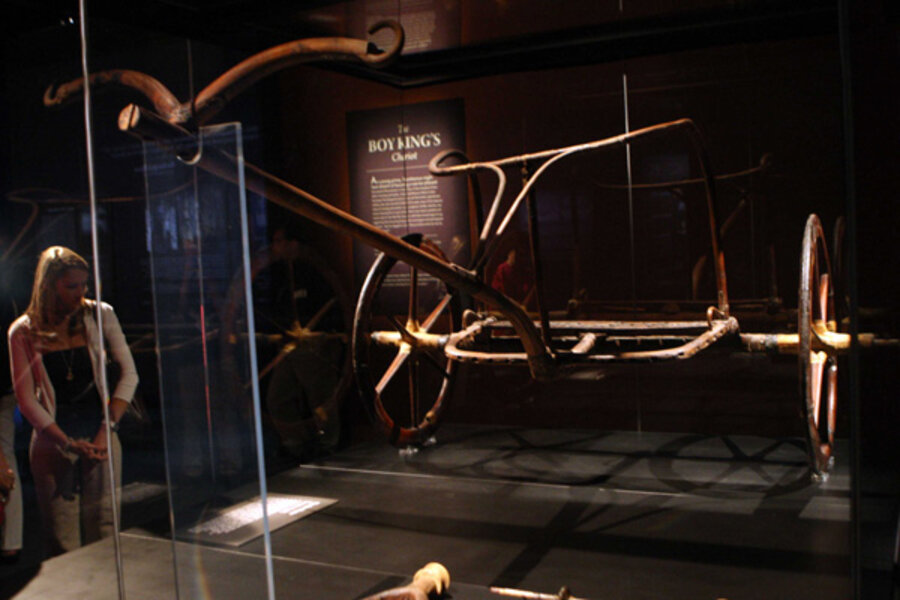Did King Tut break his leg on a joy ride? His chariot now in New York.
Loading...
| New York
When King Tut wanted to tool around the desert, perhaps hunting or leading his troops in a expedition into Nubia, he probably took his favorite chariot.
That chariot now sits in a plexiglass case in a New York exhibition space – the first time it’s ever left Egypt. Its appeal to the 19-year-old is clear: It was the Ferrari of chariot design and technology, circa 1290 BC.
The “Tutmobile” had a wide body, so there was plenty of room for the “boy king” and a driver. It was relatively sleek and open, so the wind would whip past him as he hung on while his two horses accelerated. Other early Egyptians would have marveled at the leather-covered “Pharaoh-sized” wheels, the frame construction with its subtle bends, and the soft animal skins to stand on. Moreover, the chariot used a composite of three different woods – tamarisk, elm, and birch – to add strength and flexibility.
Still, riding the chariot at 40 miles per hour over rough terrain would have been challenging. During recent electronic scans and DNA tests, Egyptian antiquity experts concluded that Tut had an accident that caused a fracture of his left leg a few hours before he died. Since almost everything Tut did was controlled – except for those times riding in the chariot – archaeologists suspect he broke his leg while out for a Pharaonic joy ride.
“This chariot is very important, not only for the life of King Tut but the death of King Tut,” says David Silverman, the curator of an exhibit on King Tutankhamen that is ending its tour of eight US cities. “Tut comes from a long line of warrior pharaohs who always talked about how skillful they were in battle and also in athletics. So it’s very possible because of the wear on the tires and the replacement on one of the tires, that this was used during this lifetime, and it was important enough to him that he took it with him in the afterlife.”
According to Mr. Silverman, DNA tests indicate that Tut had the early stages of malaria, plus a bone degenerative disease as well as a clubfoot.
“So that would have made him unstable in this chariot,” he said in an interview.
The Tut exhibit is at the Discovery Times Square Exposition through Jan. 2, 2011. Although New York is the last city on the tour, it’s the only one to show the chariot. It did not travel to the other cities in part because of space constraints, not to mention the difficulty of moving it, Silverman says. To get it to New York, exhibit officials chartered a jet.
In the exhibit are scenes of Tut standing in a chariot, holding a bow and arrow. It would have been quite a feat, Silverman says, to balance in the chariot at high speed, standing on animal skins that are sort of crisscrossed. “It does not seem that difficult to picture the young king falling out of the chariot,” he says.
When Howard Carter discovered the Tut tomb in 1922, he found six chariots in the antechamber.
“This was the lightest, the smallest, the one that was the most open. So this was the one that was used for things other than ceremonial occasions,” says Silverman.
The chariot also marks a shift that was taking place in Egypt: the use of wheels. “The Egyptians, even though they built the Pyramids, did not use wheeled vehicles for a very long time,” Silverman says. “They used a wheel for pottery, but they did not use it for transportation.”
The early Egyptians also did not have horses, he says. But about 100 years before Tut’s birth, the Hixos people from Asia brought the horse and chariot. They were quickly adapted by the Egyptians.
“Within two or three generations, the Egyptians came up with a fantastic version and improved on it year by year,” Silverman says. “So by the time we get to the 18th dynasty [Tut’s time], they have the best chariots in the Near East.”
Related:





